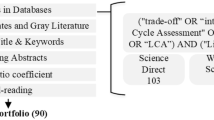Abstract
Purpose
Existing computational methods for life cycle costing (LCC) are few and appeared inconsistent with the very definition of LCC. This article improves the common matrix-based approach in life cycle assessment as applied to LCC, correcting previous errors.
Methods
Reusing a simple and hypothetical example, the authors derive the LCC from both the physical and monetary technology matrices. Accounting for the added value of all activities in the life cycle leads to a simplified computational structure for LCC.
Results and discussion
The results show that the definition of LCC and computational structure can be fully harmonized with life cycle assessments (LCAs) and simplified. In addition to eco-efficiency calculations, the vector of added values, if disaggregated over social groups, allows for distributional analysis. It is furthermore shown how LCC can account for costs shifting (economic externalities) in the same way as LCA highlights shifting of environmental externalities between different products, life cycle stages or actors.
Conclusions
Life cycle costing as defined by the sum of the added value over the life cycle is consistent with LCA and cradle to gate assessments in particular. The authors simplified the computation of LCC with either the matrix-based approach or the added values of upstream activities as an elementary exchange vector or matrix.

Similar content being viewed by others
References
Ciroth A, Franze J (2009) Life cycle costing in SimaPro. GreenDeltaTC, Berlin
Clift R, Wright L (2000) Relationships between environmental impacts and added value along the supply chain. Technol Forecast Soc Chang 65(3):281–295
Gadiesh O, Gilbert JL (1998) Profit pools: a fresh look at strategy. Harv Bus Rev 76(3):139–147
Goedkoop MJ, van Halen CJG, te Riele HRM, Rommens PJM (1999) Product service systems, ecological and economic basics. Pré Consultants, Amersfoort
Heijungs R, Settanni E, Guinée J (2013) Toward a computational structure for life cycle sustainability analysis: unifying LCA and LCC. Int J Life Cycle Assess 18(9):1722–1733
Hunkeler D, Lichtenvort K, Rebitzer G (2008) Environmental life cycle costing. SETAC, Pensacola
Rebitzer G, Hunkeler D (2003) Life cycle costing in LCM: ambitions, opportunities, and limitations. Int J Life Cycle Assess 8(5):253–256
Swarr TE, Hunkeler D, Klöpffer W, Pesonen HL, Ciroth A, Brent AC, Pagan R (2011) Environmental life cycle costing: a code of practice. SETAC, Pensacola
Weidema B, Wesnaes M, Hermansen J, Kristensen T, Halberg N (2008) “Environmental improvement potentials of meat and dairy products.” EUR 23491. EU JRC institute for prospective technological studies
Ethical statement
The work behind this article was prompted by Heijungs et al. (2013) and took place as part of the development of an advanced course in LCA given by the authors at the International Life Cycle Academy in Barcelona, Spain.
Author information
Authors and Affiliations
Corresponding author
Additional information
Responsible editor: Hanna-Leena Pesonen
Rights and permissions
About this article
Cite this article
Moreau, V., Weidema, B.P. The computational structure of environmental life cycle costing. Int J Life Cycle Assess 20, 1359–1363 (2015). https://doi.org/10.1007/s11367-015-0952-1
Received:
Accepted:
Published:
Issue Date:
DOI: https://doi.org/10.1007/s11367-015-0952-1




